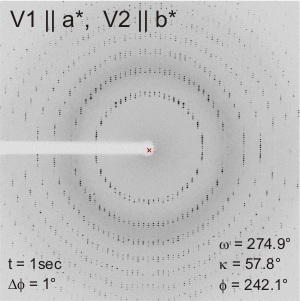Joint Research Group Macromolecular Crystallography
Multi-axis Goniometry
Multi-axis goniometry is the classical approach to cover the whole reciprocal space regardless of the crystal system and the shape and initial orientation of every crystal. Besides these facts, for decades this method has not been used for macromolecular crystallography, mainly due to its additional technically complexity.
Multi-axis goniometry is available at BL14.1 to utilize this powerful technique for the optimization of the diffraction experiments at a tunable energy beamline. Utilizing the Mini-kappa goniometer with its three rotation axes, ω, κ, and φ, crystals can now be aligned in a certain orientation with respect to the spindle axis and/or the incoming X-ray beam to minimize radiation damage and to overcome limitations of the rotation method itself.
For the calculation of the orientation specific motor values and for crystal movement the software package STAC is used which has been developed by S. Brockhauser at EMBL-Grenoble.
For the detailed instruction on how to align a crystal with STAC please refer to section Crystal Alignment.
The applications and advantages of multi-axis goniometry are described in detail in the section Alignment Scenarios. A short summary is given below.
| Standard cell alignment | Alignment of reciprocal or direct unit cell vectors along the primary rotation axis or the beam. This scenario is mainly used to check the quality of the instrument calibration and derived orientation matrix. |
| Smart spot separation | With this option the optimal orientation is calculated for maximum spot separation while minimizing the impact of the blind region at the same time. |
| Smallest overall osc. range | Using Smallest overall oscillation, the optimal orientations are calculated for minimizing the total angle of the data collection wedge, being useful for radiation sensitive crystals. |
| Multi-crystal reference | Within this option, the orientation of a previously mounted crystal is fetched to allow for the alignment of a similar but freshly mounted crystal in the same orientation. This scenario enables the combination of diffraction data from a multitude of isomorphous crystals of the same macromolecule in a very effective way. |
| Anomalous data collection | Within this scenario, a 2-, 4-, or 6-fold axis is aligned along the primary rotation axis to minimize systematic errors in recording the weak anomalous signal. |


